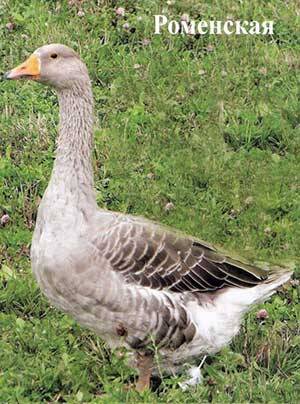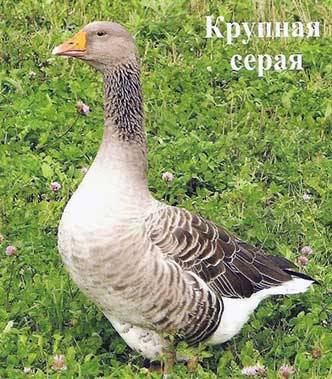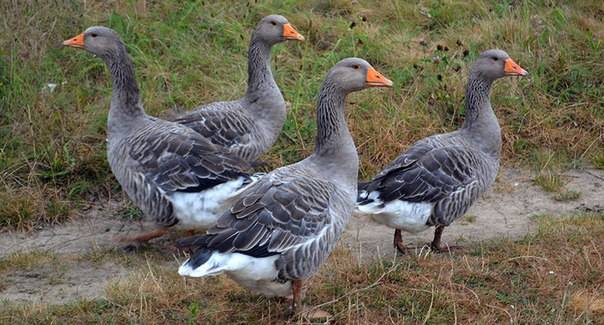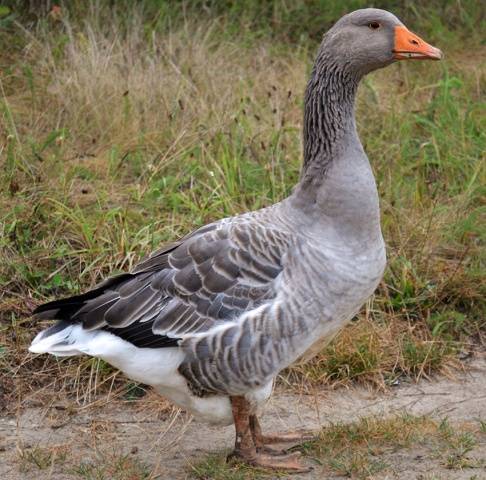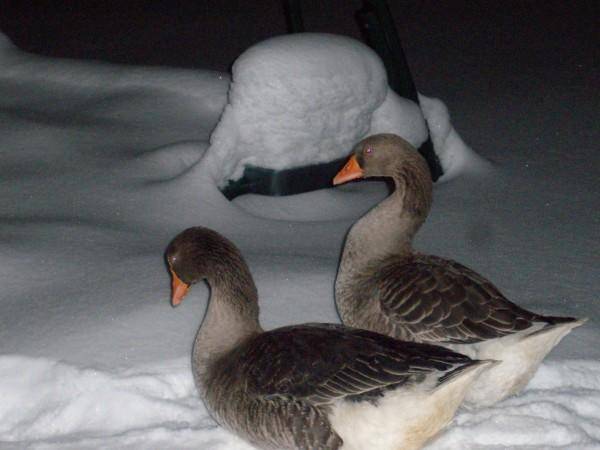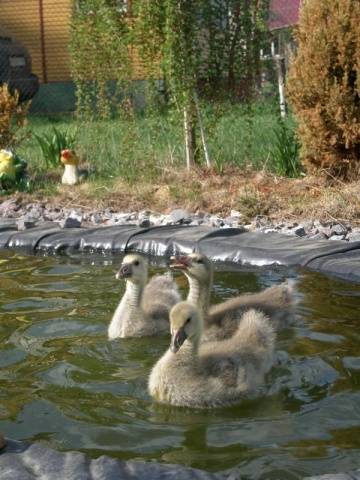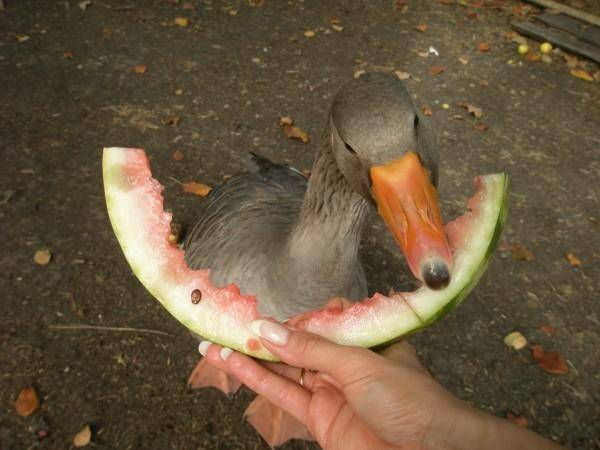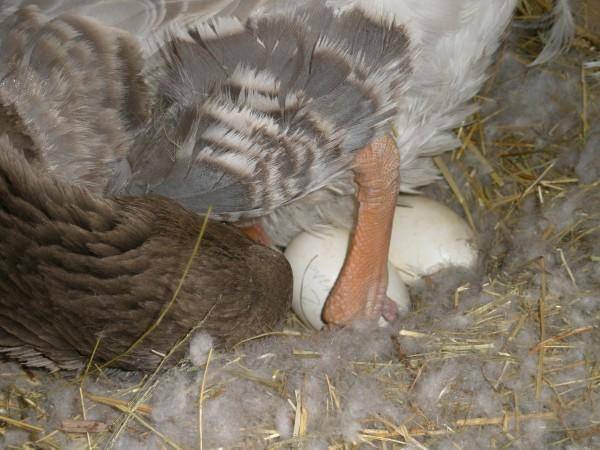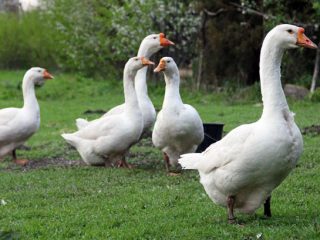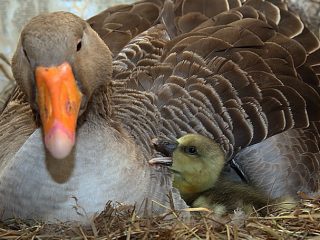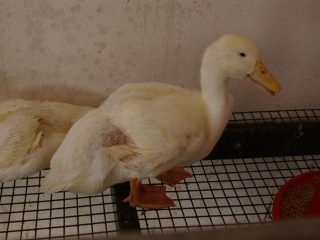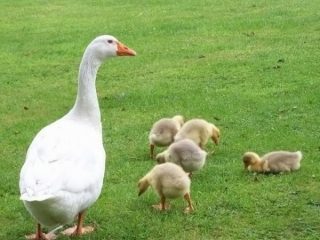Content
One of the best domestic and world breeds is a breed of geese called “large gray”. Yes, it’s that simple and no frills. Large grays were bred by crossing the Romny and Toulouse breeds.
Although the name “Romenskaya” sounds exotic, in fact there is nothing unusual here. This is a local Ukrainian breed of geese, bred in the Sumy region in the city of Romny. The Romny breed has three color options. One of the options is no different from the color of a wild goose.
They passed on the same appearance of their wild ancestors to the large grays, especially since the Toulouse breed has a similar color. How to distinguish Romenskaya from large gray? No goslings.
If it were not for the different shades of plumage on the neck and the different color of the tip of the beak, one might doubt that the photographs show different birds. In person, the differences are often more noticeable, since it is possible to see the actual dimensions. A photo without scaling does not provide such information.
In adult birds, some differences exist. At least the description of the breed is somewhat different.
Characteristics | Romenskaya | Large gray |
|---|---|---|
Weight, kg | 5,5 – 6 | 5.8 – 7 (when fattening for meat 9.01 – 9.5) |
Egg production, pcs./year | 20 | 35 – 60 |
Egg weight, g | 150 | 175 |
Color | Grey, white, piebald | grey |
Precocity | At 5 months they reach adult size | At 2 months weight 4.2 kg; 3 in size practically no different from adults |
Fertility, % | 80 | 80 |
Hatchability of goslings, % | 60 | 60 |
Romen geese are today kept as breeding material for breeding new breeds of birds of this species.
History of breeding
It is believed that the large gray breed of geese today exists in two variants: the Borkovsky Ukrainian and the Tambov steppe.
True, it is impossible to find a description of how, other than origin, these two types differ. Most likely, given the initial data, these two types have already mixed so much that it is technically impossible to distinguish between the types of geese in the photo and in the description. If the types differ in some way, it is in different requirements for content.
They began to breed a breed of large gray geese in Ukraine, where there was no issue of lack of water. At the Ukrainian Institute of Poultry Farming, first, for three years, Romny and Toulouse geese were crossed to obtain the necessary breed group - the starting material for breeding a new breed. Next, the resulting crossbreeds were bred in themselves. The main goal was to increase the live weight of the goose while maintaining the original data of the Romny breed:
- high viability;
- a well-developed brooding instinct in geese;
- unpretentiousness to living conditions;
- rapid weight gain;
- quality meat.
With the beginning of the Great Patriotic War and the arrival of the Germans, the breed group was evacuated to Tambov, where its breeding took a slightly different path. Crossing of Romny and Toulouse geese was carried out only once (there is no data on where the evacuated breed group was divided), after which the crossbreeds also began to be bred, focusing on the ability of geese to get by with a minimum amount of water. The one in the drinking bowls.
The large gray goose differs from its other parent breed, the Toulouse goose, in that egg production in geese increases until the 5th year of life, while in Toulouse goose only up to three years.
Very often I use large grays as a parent breed for crosses with “Kuban”, “Chinese”, Pereyaslavl breed and Rhine geese. A very good result is also obtained when crossing with the Gorky breed.
Gray geese are two months old, ready for slaughter:
Large gray standard, photo and description
General impression: agile, strong, large bird of “wild” color.
Head small with a short orange beak and a light tip.
Large grays do not have a purse or a cone.
Neck powerful, medium length. The goose has a shorter neck than the gander.
Back long, wide.
Breast deep.
Stomach wide, with two fat folds near the legs.
Metatarsus bright orange, strong, able to withstand the weight of a goose.
The color of the feathers should clearly show the “scales” on the back.
Flaws
A white border at the base of the beak (a sign of the Romny breed), white flight feathers and an indistinct feather pattern on the wings and back. Acceptable shortcomings include the presence of only one fat fold on the abdomen.
Vices
- purse under beak;
- bump on a forehead;
- poorly developed fold on the abdomen;
- high body position;
- small, sharp breasts;
- pale color of beak and metatarsus.
Maintenance and feeding
Since the main difference between the large gray geese is the ability to live without water, these geese don’t even need to be given a container of water. True, the owners of the breed differ in their opinions on how much this container is needed for geese.Some say that their pets prefer the company of their owners and are indifferent even to the river, others describe the joy of geese at the sight of a bathtub with water placed instead of a bucket.
If there is no pond, geese can be kept on a bed of sawdust or straw in a barn. The barn is used as a place to stay overnight or in winter. However, geese of the large gray breed enjoy walking in winter.
Regarding litter, some owners believe that it is better to lay deep litter and periodically stir it up, and clean it out only when fertilizer is needed for the garden. Others prefer a thinner layer and frequent litter changes. What to choose depends on the preferences of the owner.
If you install a deep straw bedding, you won’t even need soil. The necessary bacteria are found on the straw. But it must be taken into account that when using straw bedding, the bottom layer is not touched, sprinkling the dirt on top with fresh straw.
Since in winter the geese are given hay instead of grass, the remains of the goose meal also go into the bedding. The goose still cannot eat all the hay; it will only “gnaw” the most tender parts.
They won’t fly to Africa with the wild ones, but for a wingless and poorly running person and the “distance norm” of domestic geese of 3 m in height and 500 m in length will be more than enough to lose their property.
Therefore, if there is a suspicion that geese may change their place of residence, it is better to trim their flight feathers on the wings.
Large grays eat everything they give.Or they don’t give it, the birds take it themselves. Most owners do not feed their goslings during the summer, as they eat well on the grass. They eat well large gray overripe vegetables from the garden, unsuitable for human consumption. To the point that they don’t even need to chop anything finely; the birds themselves can crumble the same zucchini into small pieces and eat the pulp. As a dessert, geese can be offered watermelon.
But this is more likely for owners who keep large gray dogs for fun. Most goose breeders raise geese for meat and are unlikely to pamper their flock with pickles.
Breeding
Large gray geese sit well on eggs, so goslings can be hatched under brood hens. True, the owners complain that the geese sit too well. They have to be driven away from their nests so that the hen can eat.
If a hatching egg was purchased or it was decided to leave young animals hatched by old geese for the tribe, during selection it will be necessary to take a close look at potential producers. For one gander you need 2 - 3 geese.
Initially, you need to leave a larger number of geese, since not all geese will be accepted. Rejected ganders waste away, the color of their beaks and paws fades, and eventually these males die.
Moreover, sometimes it happens that geese begin to kill some member of the herd. The reason may be a lack of microelements in the feed, but more often after the slaughter of this individual it turns out that some organs were underdeveloped. For example, a gander that looks like a goose outwardly is beaten by the entire herd. But the fact is that his genitals are underdeveloped and the species does not need him as a producer.
How geese identify a defective representative remains their secret.But there is no need to try to “reconcile” the beaten individual with the rest of the herd. The rejected goose must be removed from the herd and sent for meat.
